#a little window in agnes’ life before meeting danny
Text

bad heat, nasty mosquito bites, sugary energy drinks - just a day in agnes’ life
#a little window in agnes’ life before meeting danny#getting involved with him was the peak of her self destructive behaviour tbh#myart#original character#agnes horowitz#oc#dbd oc#dbd survivor#art#digital art#digital illustration#trailer park#monster energy#cigarettes#heat#hot weather
105 notes
·
View notes
Text
LUCY'S GREEN THUMB
Unaired Episode {originally scheduled for broadcast December 6, 1986}

[Photos © Getty Images]
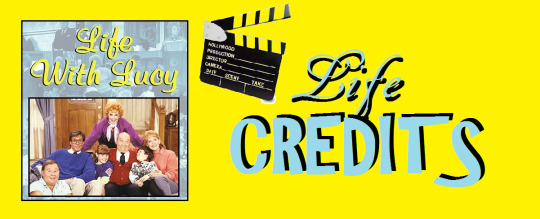
Directed by Marc Daniels ~ Written by Mark Tuttle
Synopsis
Lucy's energy drink breakfast is so unpalatable that the entire family dump it into a potted plant. When they come home, the plant has tripled in size. Realizing that Lucy may have invented a new miracle fertilizer, the pressure is on for her to recreate the concoction. But when Lucy can't recall the recipe, Curtis's dreams of fame and fortune wilt.
Regular Cast
Lucille Ball (Lucy Barker), Gale Gordon (Curtis McGibbon), Ann Dusenberry (Margo Barker McGibbon), Larry Anderson (Ted McGibbon), Jenny Lewis (Becky McGibbon), Philip Amelio (Kevin McGibbon), Donovan Scott (Leonard Stoner)
[For biographies of the Regular Cast, see “One Good Grandparent Deserves Another” (S1;E1)]
Guest Cast
Jerry Prell (Reporter) was seen on television in “The Bold and the Beautiful” and “The Young and the Restless.” Off screen he was active with New England Academy of Theater and the Hartford Conservatory.
Doris Hess (Woman with a Sick Swedish Ivy) played Tina on three episodes of “Happy Days” and small roles on “Laverne and Shirley.” Hess was particularly busy in ADR (automated dialogue replacement).
The woman's Swedish Ivy is named Helga.
Stuart Shostak (Stuart, Photographer) took a class taught by Lucille Ball in 1979 and subsequently went to work as her personal film archivist from 1981 until her death in 1989. This is his only screen acting credit. He also served as Assistant to the Producers and warm-up comedian for the series.
The reporter calls Stuart by his real first name.
Melvin, Agnes, and Helga (Potted Plants)
Others at the press conference are played by uncredited background performers.
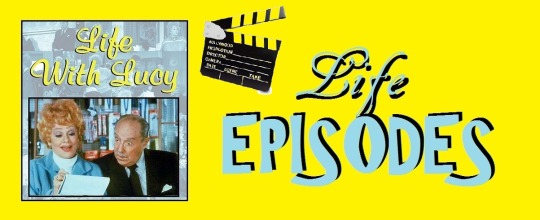
This episode was filmed ninth, but scheduled to be the eleventh one broadcast. It went before the cameras on October 21, 1986.
This is the only episode written by Mark Tuttle, who was also a writer on “Three's Company,” one of Lucille Ball's favorite shows. His career started in 1963 writing for “The Beverly Hillbillies.” He had worked with director Mark Daniels on two episodes of the TV series “Private Benjamin” (1981-82).
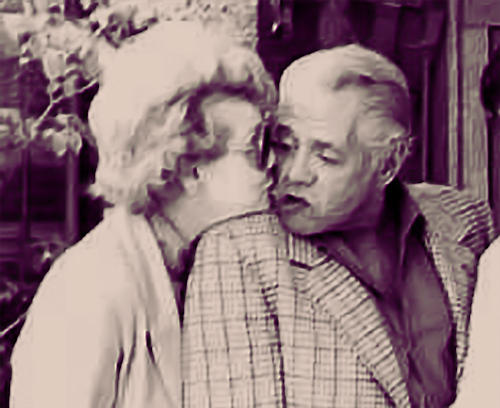
On December 2, 1986, just two weeks after “Life Was Lucy” was canceled, Desi Arnaz Sr. died from lung cancer at the age of 69. His final screen appearance was on “The David Letterman Show” in 1983. These two events devastated Lucille Ball and she became despondent.
Lucy: “I'm just a big flop.”
On December 6, 1986, “Life With Lucy” (and ABC's entire Saturday night line-up) was replaced by Christmas specials.
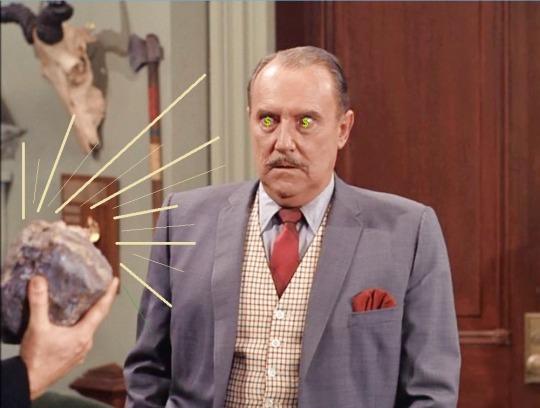
Curtis: “I'm just going to be a small businessman with a small store.”
In this episode,Curtis becomes obsessed with making money, just like his previous “Lucy” characters Alvin Littlefield (“I Love Lucy”), Mr. Mooney (“The Lucy Show”), and Harrison Carter (“Here's Lucy”, above).
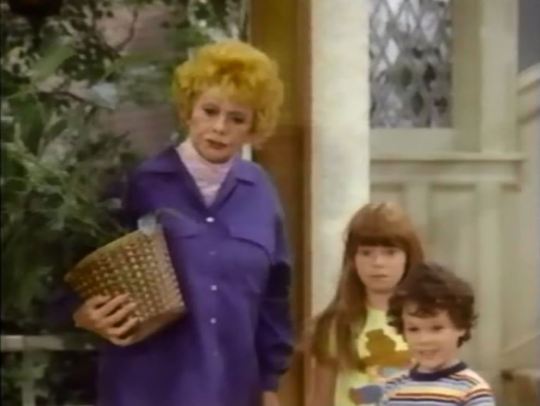
The very first time Lucille Ball was seen on “Life With Lucy” she was carrying a potted plant (a schefflera). Lucy was afraid it had spider mites.
Lucy: (To Melvin) “The free ride is over! You either get growin' or get goin'!”
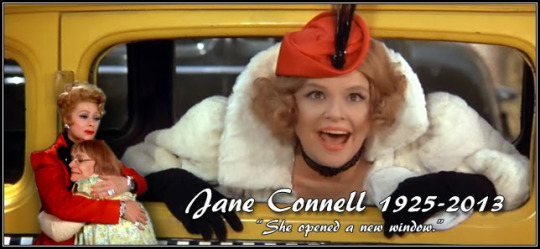
The living room now is home to two potted plants: Agnes (on the coffee table) and Melvin (on the table behind the sofa). Lucy begins the episode saying good morning to Agnes. Hearing Lucy say “Agnes” reminds us of Mame, the 1974 film in which one of the major characters was named Agnes Gooch (Jane Connell).
Lucy: “My mind is a blank!”
Curtis: “We know that!”

Unbeknownst to Lucy, the entire family dumps Lucy's healthy breakfast (a super-strength organic energy drink) into Melvin's pot rather than swallow it. When they come home, Melvin has tripled in size!

It is worth noting that a man named Melvin Frank directed Lucille Ball in the 1960 film The Facts of Life. [The plant behind Lucy is mere coincidence!]
Margo: (about Melvin's growth spurt) What could have made it grow so fast?”
Kevin: “I know. (pointing up) Aliens!”
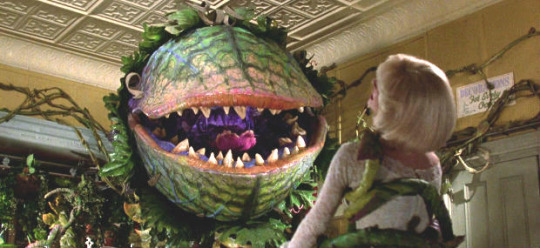

This episode slightly resembles the 1960 film (and stage and screen musical) Little Shop of Horrors, in which a plant mysteriously grows to enormous size. The plant's origins are also attributed to aliens! In this case, instead of blood, its life-force is derived from Lucy's energy drink. The musical film was released on December 19, 1986, just two weeks after this episode was scheduled to air, but the stage musical had been playing off-Broadway since 1982 and would out-last “Life With Lucy” by a full year.
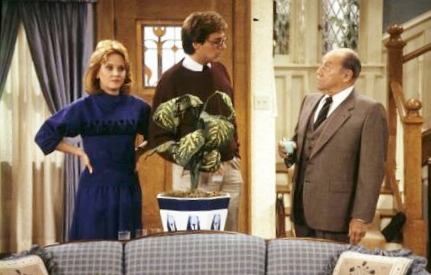
Curtis comes up with the name Gigant-a-Grow for Lucy's miraculous growth potion.
Curtis: “From now on, when you hear the name McGibbon, you'll think fertilizer!”

Margo tells her mother that thanks to her discovery she'll be in the encyclopedia next to Luther Burbank. Luther Burbank (1849-1926) was a pioneering horticulturalist who developed more than 800 varieties of new plants in his career. A Californian, many schools and public buildings have been named after him. In 1986 he was inducted into the National Inventors Hall of Fame.
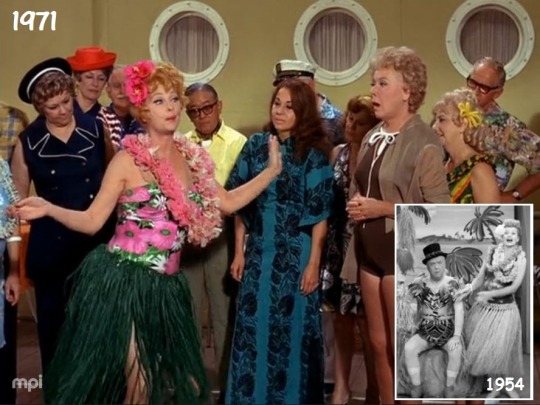
Curtis promises Leonard three weeks paid vacation. He plans to go to Hawaii to lie on the beach. This is the third mention of Hawaii in the series. In the first episode, Curtis had just returned from vacationing there and in the second episode guest star John Ritter says that his wife is Hawaii with the kids. Hawaii was a popular destination with Lucille Ball and her sitcom characters. It was also a favorite get-away destination of the Arnaz family, has been mentioned since the early days of “I Love Lucy”, even before it officially became a state!

On the telephone, Curtis asks a reporter if they've got a connection with “60 Minutes.” He thinks the story of Lucy's Gigant-a-Grow would be perfect for Morley Safer. The CBS TV prime time news magazine show began airing in 1968, the same year as “Here's Lucy.” Safer was a host of “60 Minutes” from 1968 until his death in 2016.
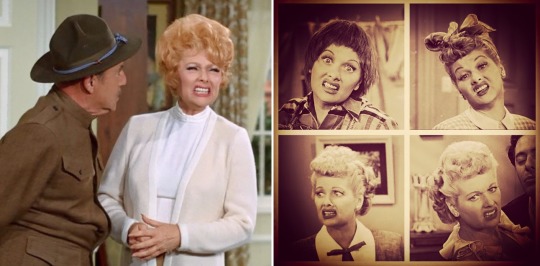
Lucy briefly does her famous 'spider' face “ewww” when Curtis threatens to get the formula out of her head “one way or another.” Unfortunately, the moment is obscured by background music fading out to commercial and the omnipresent laugh track.
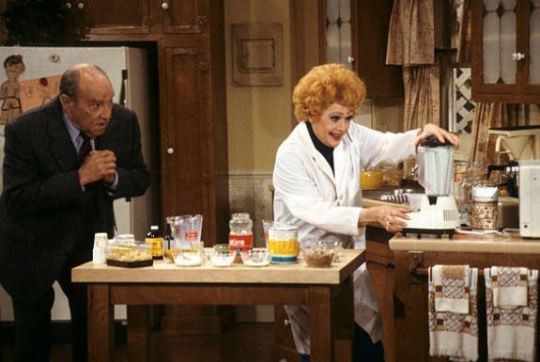
The recipe for Lucy's 11th attempt at duplicating Gigant-a-Grow:
1 ounce of ginseng extract
3 drops of lecithin
gobs of garlic powder
wonderful (God-given) wheat germ
yeast to rise it to heaven
blend on high


In “Ethel's Home Town” (ILL S4;E15) a old vaudeville gag makes it appear that a potted plant grows into a tall tree – all behind the back of Ethel Mae Potter (we never forgot her)!

When the Ricardo's rent their Connecticut home to the Williams family in “Lucy Makes Room for Danny” (LDCH 1958), Lucy is worried if they will take care of her houseplants. When Ricky finds out she's been rescuing them against his wishes, she physically demonstrates how badly wilted they'd become.

In “Lucy's Mystery Guest” (TLS S6;E10) Lucy Carmichael is plant-sitting for a neighbor when her health nut Aunt (Mary Wickes) sprays the plant for bugs, and it promptly wilts.
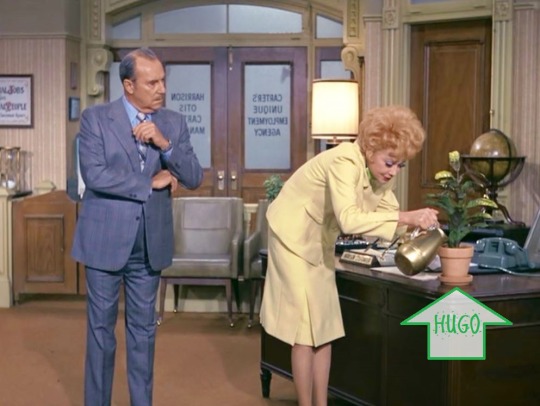
In “Lucy and Mannix are Held Hostage” (HL S4;E4) Lucy Carter suddenly starts naming and talking to her plants. Their names are Ruthie, Hugo, and Priscilla. Ruthie meets an untimely end when she is tossed out a window in an attempt to stop a robbery.
This Day in Lucy History {had this episode aired as planned on December 6th}

"Ricky's Contract" (ILL S4;E10) – December 6, 1954

"Lucy Saves Milton Berle" (TLS S4;E12) – December 6, 1965

"Lucy in the Jungle" (HL S4;E13) – December 6, 1971
#Life With Lucy#Lucille Ball#Gale Gordon#Ann Dusenberry#Donovan Scott#Philip Amelio#Jenny Lewis#Larry Anderson#plants#Little Shop of Horrors#Marc Daniels#Mark Tuttle#Jerry Prell#Doris Hess#Stuart Shostak#Desi Arnaz Sr.#Agnes Gooch#Melvin Frank#Luther Burbank#Hawaii#60 Minutes#Morley Safer#Health Drink#1986#ABC#TV
1 note
·
View note
Photo

New Post has been published on http://www.classicfilmfreak.com/2017/12/14/fourteen-hours-1951-starring-paul-douglas-and-richard-basehart/
Fourteen Hours (1951) starring Paul Douglas and Richard Basehart
The suspense of a man on the edge of a ledge will keep you on the edge of your seat.
Although he turned more to Westerns toward the end of his career and in the early 1950s displayed his versatility in a cluster of divergent films—a medieval epic that included a sojourn to China, a naval comedy, the obligatory Western, a biography of German general Rommel and a cold war yarn—director Henry Hathaway, in 1951, made a foray into yet another area of motion picture entertainment, the psychological thriller.
The single theme that occupies the entire Fourteen Hours could be summed up in the simple question: Will he or won’t he? Jump, that is.
A young man (Richard Basehart) checks into a room on the fifteen floor of a New York City hotel for the sole purpose of committing suicide. From the ledge outside his room, he keeps busy an array of people working to coax him to come inside.
There is his distraught mother (Agnes Moorehead), not too distraught to reveal her own counterproductive psychoses; the psychiatrist (Martin Gabel) who has Cosick’s problem all figured out, or so he thinks; the over zealous evangelist (George MacQuarrie) who only wants to “save” him, jeopardizing one plan to “save” him in another way; and, most of all, the conscientious and compassionate New York policeman (Paul Douglas) who tries every approach to talk him in, and after he becomes so frustrated he taunts the man to jump, has one last idea.
The tension that saturates the film could have been taken to the extreme, made to last practically forever, with even more characters and any number of contrived subplots—there is, however, one brief and errant foray—but both director Hathaway and screenwriter John Paxton—Murder, My Sweet (1944), Crossfire, (1947), Pickup Alley, (1947), known best for crime dramas and film noirs—maintain a tight rein on the plotting and story.
Those fourteen hours include, of course, what could be called a “night watch” and more clandestine strategies to save the man—search lights, which only frighten him, and a police scheme to lower a man from the roof above in an attempt to grab him, which he spots despite Charlie Dunnigan’s efforts of distraction.
And below, through it all, are the swarm of observers, some who want him rescued and others, typical of the worst in human nature, who want him to jump and provide the entertaining thrill they crave.
Seemingly unconcerned about their duties and unregulated by their bosses, some five NYC cab drivers follow the goings-on, sustained on the sidewalk below with coffee and instantaneous news reports on a portable radio. Bets are even taken on when this guy will jump. The drivers include actors Ossie Davis and Harvey Lembeck.
The closest thing to a romance in the film is an accidental meeting in the crowd of two office co-workers, Danny (Jeffrey Hunter, in his film début) and Ruth (Debra Paget). Danny especially works toward some kind of relationship with the initially shy young lady.
Before he first goes to the window, Dunnigan removes his coat, tie and cap, to allay in the man any latent fears of a policeman. Prompted by the psychiatrist, Dunnigan tries unsuccessfully, at least at first, to relate to the man, one human being to another, man to man.
The police discover the nameless stranger is Robert Cosick and locate his mother, who is of little help. The father (Robert Keith) provides only another dead end, as the psychotic mother has instilled in her son a hatred for him. Even when the mother reveals a girl in Cosick’s life, and his estranged fiancée, Virginia (Barbara Bel Geddes), comes to try and talk him in, even this proves fruitless.
The one distracting subplot, perhaps the film’s most serious misstep, unfolds in a nearby law office where a woman (Grace Kelly) is about to sign her final divorce papers. After watching the drama on the ledge during the legal proceedings, she decides to reconcile with her husband.
The scene feels “inserted,” a glaring departure from the story line. Kelly’s début in the movies, if that, indeed, was the scene’s sole purpose, went unnoticed by critics. Gary Cooper, on a visit to the set, was sufficiently impressed to suggest Kelly as his wife in the upcoming High Noon (1952).
In the end, Dunnigan does develop the best rapport of any one with his “client,” though at one point frustrated, the policeman says, “I don’t know why I care, but I do.” The rapport is reciprocated. After that hostile encounter with his father, Cosick remarks, “I could never talk to my father the way I’ve talked to you.”
Dunnigan seems close to success when he convinces Cosick “to come in, take a shower and think things over. I’ll clear everybody out of the room, give you the key and you can lock yourself in.” When Dunnigan gives his word, Cosick agrees. The room is supposedly cleared, but an overlooked policeman is crouching behind an upholstered chair. Before he can make a move, the evangelist, who has sneaked up the back stairs, rushes into the room. “Kneel and pray! Kneel and pray!” Cosick flees back to the ledge.
By now it is night and once again, somehow, despite the apparent betrayal, Dunnigan has regained Cosick’s trust, now with an invitation to meet his wife—“she’s a good cook”—and take him fishing for flounder on Sheepshead Bay. Cosick is stepping toward the window when a boy on the street below does his impersonation of a skyscraper jumper and accidentally switches on a spotlight. Cosick is distracted, loses his balance and falls. The police had quietly hung a net below the ledge, and Cosick grabs it and is hauled to safety.
While Dunnigan greets his wife and son at the entrance of the hotel, Danny and Ruth, hand in hand, walk away down the dark street.
The only musical score heard in the 20th Century-Fox film, by resident composer Alfred Newman, is behind the main title and at the very end, to accompany Hunter and Paget.
Besides Jeffrey Hunter and Grace Kelly, Fourteen Hours provides the film début or second film for many of the extras, including Richard Beymer, John Cassavetes, Joyce Van Patten, Ossie Davis and Harvey Lembeck. Among the up-and-coming stars is Brian Keith, the son of Robert Keith, who plays Cosick’s father.
Like so many Hollywood films, a happy ending replaces the real-life, tragic incident related in Joel Sayre’s story, from which John Paxton fashioned his screenplay. In 1938, a twenty-six-year-old man leaped from the seventeenth floor of the New York City Hotel Gotham. There was no net, no policeman to save him. In a similar tragedy related to the film, the daughter of a Fox executive leaped to her death the day of the film’s preview, prompting a six-month delay in the official release.
youtube
0 notes